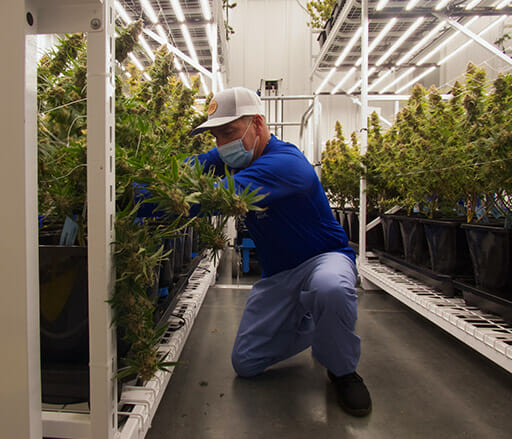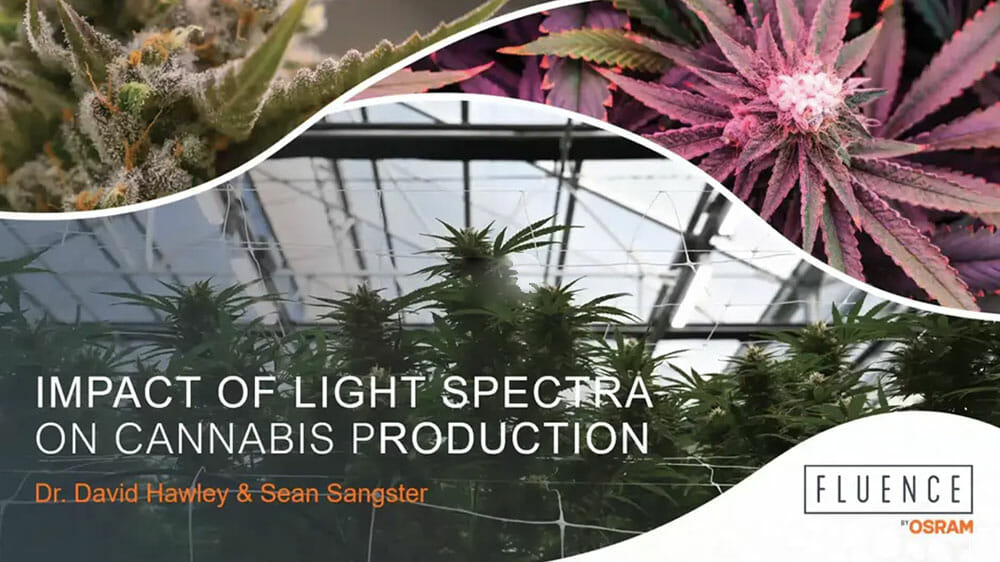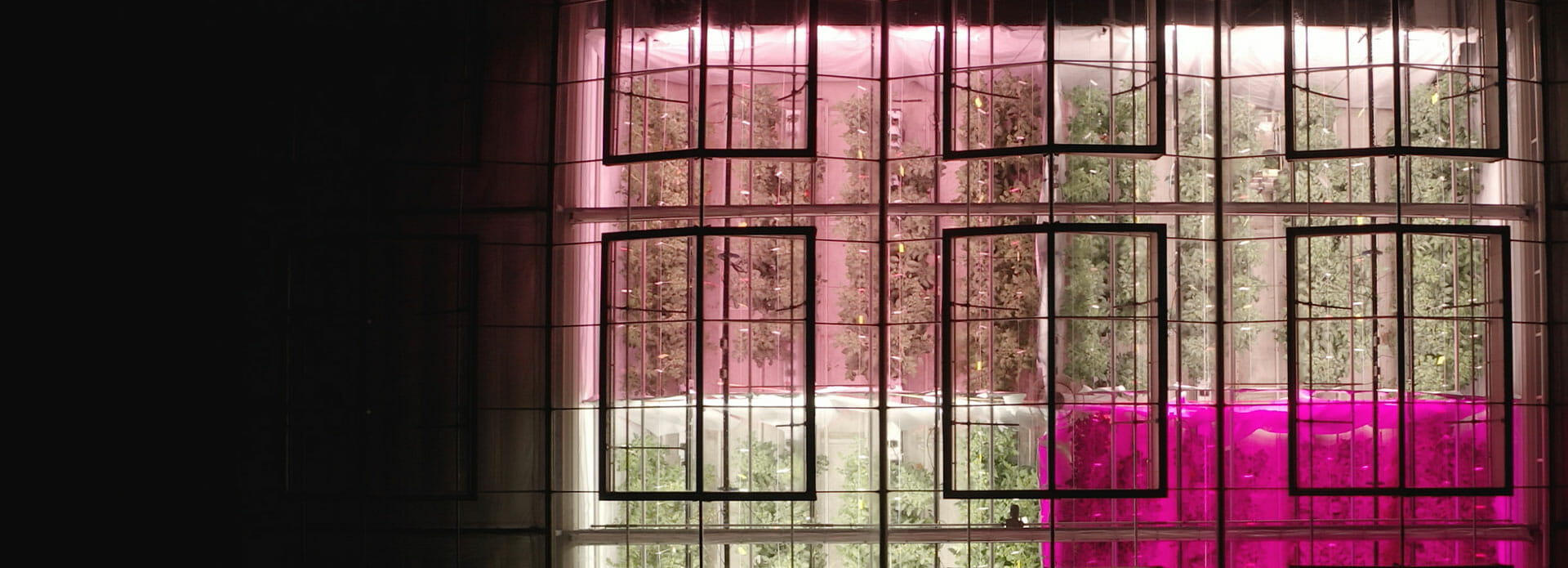Should growers match wattage or PPFD in their LED retrofit?

Taylor Kirk is a horticulture service specialist for Fluence, where he strives to help the world grow smarter by consulting growing partners and collaborating with researchers and other cannabis industry leaders. He has more than 20 years of experience in agriculture, with a diverse background in agronomics and a bachelor’s degree in agronomy from Texas A&M University.

KEY TAKEAWAYS FOR CANNABIS GROWERS CONSIDERING AN LED RETROFIT:
- Retrofitting a facility with LED lights can have cascading effects on facility design, particularly when it comes to sensible and latent HVACD load.
- Growers will ultimately have to decide between matching wattage or matching PPFD with their new LED fixtures. Wattage matching will achieve greater light intensity, while PPFD matching will achieve greater operational savings.
- Based on the latest Fluence research, growers should choose the option that achieves a PPFD of more than 1,000 µmol/m2/s.
- Cultivators and directors of operation need to work closely with their mechanical engineers—whether they’re on-site staff or third-party contractors—to understand how a LED retrofit affects:
- Wattage and PPFD matching.
- Peak HVACD load.
- Dehumidification.
- Duct flow and design.
- Integrated and seasonal energy efficiency ratios.
- Adjustments to set points and other environmental factors.
TERMS TO KNOW:
- Sensible load: The amount of energy required to increase, decrease or maintain the air temperature of a controlled environment.
- Latent load: The amount of energy required to remove moisture in a controlled environment, particularly as it pertains to plant evapotranspiration rates.
- Energy efficiency ratio: The ratio of cooling output to electricity input.
- Set point: The fixed temperature your HVACD system maintains.
- PPFD: The amount of photosynthetically active radiation that actually arrives at the plant. It is a ‘spot’ measurement of a specific location on your plant canopy, and it is measured in μmol/m2/s.
The Challenge
More and more growers recognize the value that LED lighting systems provide to their operations, both in terms of top-line benefits like plant quality and consistency and in long-term operational savings.
But the decision to retrofit a facility with LEDs presents a critical question for cultivators that impacts overall lighting strategy and facility design: Should I match my previous wattage or match my previous PPFD levels?
Both options have benefits and limitations that present new challenges for growers, and the decision is largely determined by the PPFD levels used in your lighting strategy under your old fixtures. We’ll dive more into that a bit later.
Underpinning this challenge is the fact that facilities were not necessarily designed with LEDs in mind. This is especially true for HVACD systems that were designed to maintain controlled environments that used ceramic metal halide (CMH) or high-pressure sodium (HPS) fixtures.
Because LEDs are more energy efficient and emit less heat than legacy systems, you can likely achieve the same light intensity with fewer watts if you match PPFD, and you’ll likely have a reduced sensible load on your HVACD system. With your new LEDs under reduced wattage, you can maintain better control over your air temperature and cooling methods and can shift your focus to other critical factors like ensuring you’re properly circulating and ventilating air throughout the facility.
With either a PPFD or wattage mage, adjusting sensible load to maintain a set temperature point could also impact plant evapotranspiration rates if leaf surface temperature changes, in turn affecting the environment’s humidity and latent HVACD load.
You’ll also have to consider other factors like irrigation, seasonal changes, HVACD duct layout, and air flow. It’s a lot to compensate for and I rarely see growers account for every factor. But that’s why Fluence has a horticulture services team in the first place. We’re there on the ground with you factoring all of these potential adjustments into the facility design equation.
The Solution
There is no universal answer to whether you should choose a wattage or a PPFD match in your LED retrofit. In the end, it mostly boils down to your previous PPFD levels. That’s because recent Fluence research has shown that growing cannabis under high PPFD—more than 1,000 μmol/m2/s—will enhance plant growth and maximize your facility’s production potential.
So, if you previously used high PPFD levels of more than 1,000 μmol/m2/s, our recommendation would likely be to match that with your new LEDs. You’ll see an immediate reduction in wattage and capitalize on the newfound opportunity for operational savings while maintaining or even improving yield, crop consistency and quality.
But let’s say your previous PPFD levels fell well short of the recommended 1,000 μmol/m2/s. In this scenario, we might opt for a wattage match. The energy output will remain the same, but we’ll drastically increase light intensity to improve yield. I’ve seen some growers using this strategy to improve yield by as much as 20 to 25 percent, depending on the cultivar, lighting strategy and how they optimize other environmental conditions like supplementing CO2 to account for greater light intensity.
Wattage and PPFD matching provide tangible benefits in the forms of operational savings, crop enhancements or both. More broadly, LEDs when deployed under the right conditions allow growers to improve quality and manipulate secondary metabolites in certain chemovars. For medical cannabis producers, for instance, this is a huge factor that can give them a competitive advantage. Not to mention the savings you’ll generate when you don’t have to replace bulbs every 10,000 or 20,000 hours.
Applications for growers
Making the decision on matching PPFD or wattage can be complicated due to the sheer number of variables growers might have to consider across their entire facility. The good news is that you don’t have to make that decision alone. It’s my responsibility—and the responsibility of the entire horticulture services team—to help cultivators make the right decision and solve for the challenges that arise during a LED retrofit.
The biggest piece of advice I give to growers when working through this decision is to talk to their mechanical engineer or systems integrator. Walk them through how you’re matching your new LED system’s wattage or PPFD to your previous system’s and how it will affect sensible and latent load.
Know your watering rate per plant and benchmark air temperature and humidity, surface leaf temperature and evapotranspiration rates, as each of those will impact latent load. Ask them how seasons will affect sensible load and energy efficiency ratios. If you operate a facility in a cold climate and you’re getting pummeled with snow five months out of the year, how will that impact HVACD performance and sensible load?
Ask them if the retrofit will mean you need to change how the air ducts move air throughout the facility to achieve your desired environmental conditions. Determine if you need to change your fixture configuration and placement to compensate for air flow.
Finally, if you don’t measure photosynthetic photon flux density (PPFD), start. As I mentioned earlier, our latest research shows that growing cannabis under high PPFD—more than 1,000 μmol/m2/s—will enhance plant growth and maximize your facility’s production potential. More importantly, it’s just a critical metric to track as it impacts carbon dioxide levels and gives you a sense of how much light you can deliver to your plants without hitting a saturation point.





